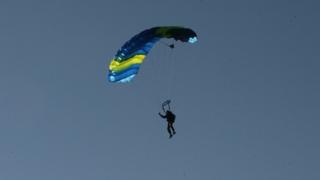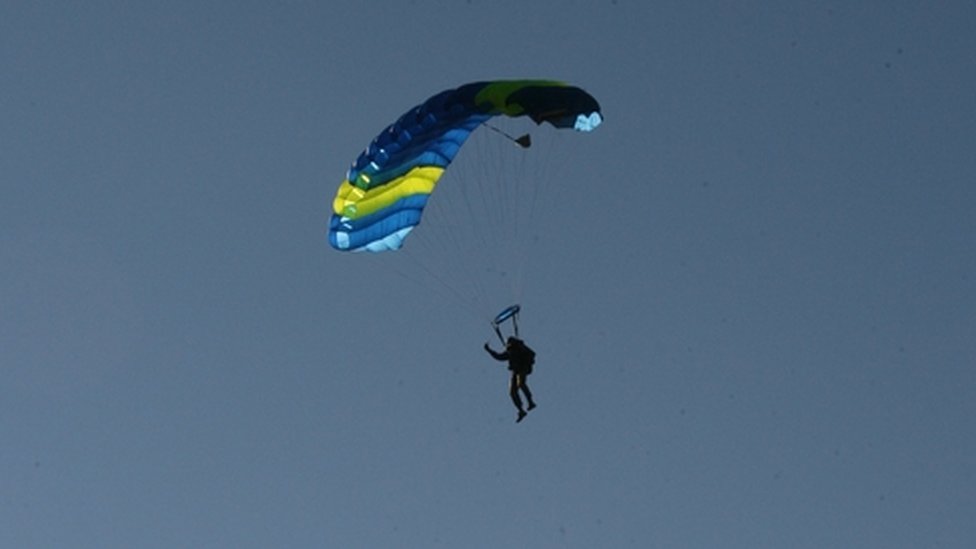
Former army fitness instructor Emile Cilliers has been convicted of trying to murder his wife, Victoria, by tampering with her parachute. She survived a 4,000ft fall. But how can a human being do this?
The ground’s getting nearer fast. You pull the cord to open your parachute. Except, nothing happens. Your body’s still hurtling towards Earth with only drag – air friction – to slow it down. So you try the emergency back-up parachute – and, once again, it fails.
The moments between this happening and the skydiver’s body hitting the ground – or water – are usually their last.
But not for Victoria Cilliers. The 4,000ft (1,200m) fall caused by her husband tampering with her parachute resulted in several broken bones, but not death.
Hers is far from being the greatest height from which someone has dropped and survived. According to the Guinness Book of World Records, flight attendant Vesna Vulović lived on after she was thrown from a DC-9 at an altitude of 33,333ft (10,160m) in 1972.
Ulf Björnstig, senior professor of surgery at Sweden’s Umeå University, has co-authored several studies on the risks of parachute jumps. He describes the chances of living after an unimpeded fall of several thousand feet as “very small” and says Mrs Cilliers and Ms Vulović are “lucky cases”.
But after a point, the height from which a person falls won’t make a difference to how fast they are going. It’s estimated that the human body in freefall reaches 99% of its terminal velocity (full and final speed) after dropping 573m (1,880ft), which usually takes 13 to 14 seconds.
Crater in the snow
So can a parachuteless skydiver do anything to slow down his or her descent? Prof Björnstig thinks so. The final speed reached when “falling flat” – body, hands and arms stretched out as widely as possible – is about 200 km/h (124mph), he says. “Trying to increase the speed, such as by diving head-first and minimising the drag, may give a falling speed up to 420 to 430 km/h.”
Even if a skydiver minimises his or her falling speed, what surface is best to land on?
In 2009, James Boole, from Staffordshire, fell from 6,000ft (1,829m) above Russia. He hit snow, leaving a crater but survived.
In 2006, Michael Holmes, a highly experienced skydiver from Jersey, fell two miles (3.2km) when his main and reserve parachutes failed. He had the good fortune to land on a blackberry bush.
Mrs Cilliers came down in a ploughed field near Netheravon Airfield, on Salisbury Plain, Wiltshire, breaking her pelvis and ribs and fracturing some vertebrae. The surface has been described as unusually soft.
Prof Björnstig says someone reaching terminal velocity needs at least half a metre of give – or deceleration distance – in the surface or object they hit to avoid fatal injuries. He recommends “forgiving structures”, such as snow, a swamp or the branches of a tree.
The skydiver has to steer to get there first. This is hard, but it can be done.
Box position
To demonstrate, in July 2016, stuntman Luke Aikins did a pre-planned jump with no parachute, landing on a net suspended above the California desert.
“It is tiny from 25,000ft,” he told NBC’s Today programme. “You can’t really make out the net. You can see the ground where you need to go. As you start getting closer and lower, you’re able to make out landmarks a little better.”
Skydivers adopting the “box position” – lying front-down with legs stretched out and arms and head raised up and forming a “W” shape – are able to move horizontally in the air. They can bank their arms like an aeroplane’s wings.
“Taking all the factors into account – for example, trying to fly in the direction of a softer landing area (if possible) – may of course have a potential to increase the chance of survival,” says Prof Björnstig.
Finally, there’s the last point at which skydivers can do anything to help themselves – on impact.
After trying to lie as flat as possible while falling, with arms and legs stretched out to maximise drag, they should turn around to adopt a different position when near the ground.
“Landing with feet first would be a reasonable tactic,” Prof Björnstig says.
Skydivers, when their parachutes actually work, are advised to land on the balls of the feet first, rolling to the side. Another dictum is to keep the legs springy by bending the knees slightly. But any difference this would make to someone going at 200km/h is debatable.
Skydiving is a high-adrenalin hobby, and the British Parachute Association describes the risk succinctly.
“There is no such thing as a totally safe parachute jump,” it says.
And about one in 100,000 jumps by fully trained parachutists ends in death.
Once a parachute fails, nous and experience help survival chances, but luck even more so.















Leave a comment